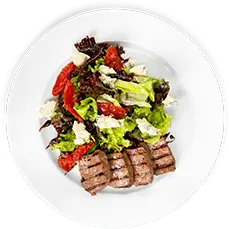Uczucie głodu, często kojarzone z pustym brzuchem, tak naprawdę jest spowodowane czymś zupełnie innym niż brakiem pożywienia w żołądku. Głód nie powstaje w brzuchu. To niemiłe uczucie powstaje w naszej głowie i jest związane z niskim poziomem cukru w naszym organizmie. Dzieje się tak, gdy przyzwyczaimy mózg do łatwo przyswajalnego, ale krótkotrwałego źródła energii, jakim są węglowodany i różne odmiany cukru. Nasz mózg szybko uzależnia się od stałego dopływu „łatwej” energii i domaga się kolejnych posiłków, co większość osób utożsamia z głodem. Paradoksalnie więc jedzenie węglowodanów nie zaspokaja głodu, a wręcz przeciwnie, wywołuje go!
Przypomnijmy, że nasz organizm może działać na dwóch rodzajach „paliwa”. Są nimi glukoza (której źródłem są węglowodany i cukier) oraz tłuszcz. Nasz organizm nie potrafi magazynować glukozy, dlatego zamienia jej nadmiar na tłuszcz i magazynuje na „później” w komórkach tłuszczowych. Problem w tym, że nasz organizm nie jest w stanie odkładać węglowodanów „na później”. Kiedy jesz posiłek obfity w węglowodany – jest on bardzo szybko trawiony i opuszcza żołądek. Wraz z opróżnieniem żołądka bardzo szybko powraca poczucie głodu. Szybko pojawia się też zmęczenie i poczucie, że należałoby znów coś zjeść. Dzieje się tak, ponieważ glukoza, w którą zamieniane są węglowodany, może napędzać organizm bardzo krótko.
Już po godzinie czy dwóch, nawet po zjedzeniu obfitego posiłku czujemy się „głodni”. Stąd wzięło się błędne przekonanie, że należy jeść 5 posiłków dziennie. Tyle tylko, że nie zaspokajają one potrzeb organizmu, a zagłuszają jedynie sygnały wysyłane przez mózg z powodu braku cukru. Na tym nie koniec, ponieważ nadmiar cukru przetwarzany jest i odkładany przez organizm w postaci tłuszczu.
W takim razie jak pozbyć się uczucia głodu? Odpowiedzią jest przestawienie się na wykorzystanie tłuszczu jako paliwa dla organizmu. W odróżnieniu od cukrów (węglowodanów), może on zasilać nasz organizm przez cały czas. Dzięki temu, że jest on dostępny dla organizmu bez przerwy, ponieważ jest przez nas naturalnie magazynowany – pozwala na stałe zasilanie organizmu w niezbędną mu energię i składniki odżywcze. Co więcej, pobieranie energii z tłuszczu pozwala na uniknięcie opisanych wyżej napadów uczucia głodu, spowodowanych skokami cukru we krwi. W trakcie zmiany nawyków uczucie głodu występuje tylko w początkowym okresie, ponieważ mózg jest przyzwyczajony do pozyskiwania energii z węglowodanów. Gwarantujemy, że to uczucie z czasem mija, pojawia się natomiast cały szereg pozytywnych zjawisk: zwiększona ilość energii, lepsze samopoczucie, naturalnie występująca utrata wagi czy poprawa nastroju.
